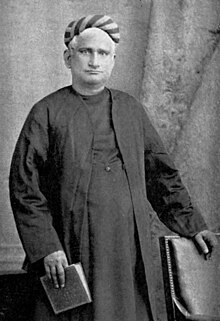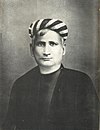Bankim Chandra Chatterjee
Bankim Chandra Chattopadhyay | |
|---|---|
 | |
| Native name | বঙ্কিমচন্দ্র চট্টোপাধ্যায় |
| Born | 26 June 1838[1][2][3] Naihati,Bengal,British India |
| Died | 8 April 1894(aged 55) Calcutta,Bengal,British India |
| Pen name | Kamalakanta |
| Occupation | Writer, poet, novelist, essayist, journalist, government official |
| Language | Bengali, English |
| Alma mater | University of Calcutta |
| Literary movement | Bengal Renaissance |
| Notable works | Durgeshnandini Kapalkundala Devi Chaudhurani Anandamath Bishabriksha |
| Signature | |
| Website | |
| Bankim-Rachanabali administrated by eduliture | |
Bankim Chandra Chattopadhyay(anglicized asChatterjee)CIE(26 or 27 June 1838[4]– 8 April 1894[5]) was an Indian novelist, poet, essayist[6]and journalist.[7][8]He was the author of the 1882Bengali languagenovelAnandamath,which is one of the landmarks of modern Bengali and Indian literature. He was the composer ofVande Mataram,written in highlySanskritisedBengali,personifyingIndiaas amother goddessand inspiring activists during theIndian Independence Movement.Chattopadhayay wrote fourteen novels and many serious, serio-comic, satirical, scientific and critical treatises inBengali.He is known asSahitya Samrat(Emperor of Literature) inBengali.[9][10][11][12][13]
Biography[edit]
Chattopadhayay is widely regarded as a key figure in literary renaissance of Bengal as well as the broaderIndian subcontinent.[7]Some of his writings, including novels, essays and commentaries, broke away from traditional verse-oriented Indian writings, and provided an inspiration for authors across India.[7]

Chattopadhayay was born in the village of Kanthalpara in the town ofNorth 24 Parganas, Naihati,in an orthodoxBengali Brahminfamily, the youngest of three brothers, to Yadav Chandra Chattopadhayay and Durgadebi.His ancestors hailed from Deshmukho village inHooghly District.[14]His father, a government official, went on to become the Deputy Collector ofMidnapur.One of his brothers,Sanjib Chandra Chattopadhyaywas also a novelist and is known for his book "Palamau".Bankim Chandra and his elder brother both went toHooghly Collegiate School(then Governmental Zilla School), where he wrote his first poem.He was educated at theHooghly Mohsin Collegeand later atPresidency College, Kolkata,graduating with a degree in arts in 1859. He later attended theUniversity of Calcuttaand was one of two candidates who passed the final exam to become the school's first graduates.[15]He later obtained a degree in law in 1869. Following his father's footsteps, Bankimchandra joined the Subordinate Executive Service. In 1858, he was appointed a Deputy Magistrate (the same type of position held by his father) ofJessore.After merging of the services in 1863, he went on to become Deputy Magistrate & Deputy Collector, retiring from government service in 1891. Bankim Chandra Chattopadhyay was the first in-charge (Sub-divisional magistrate) of theArambag subdivisionin its earlier days. The ruins of a fort atGar Mandaranprovided the setting for Bankim Chandra Chattopadhyay's novelDurgeshnandini,published in 1865. His years at work were replete with incidents that brought him into conflict with the colonial government.He was, however, made a Companion of the Most Eminent Order of the Indian Empire (CMEOIE) in 1894.[16]He also received the title of Rai Bahadur in 1891.
Literary career[edit]
This sectionneeds additional citations forverification.(April 2017) |
Chattopadhyay's earliest publications were inIshwar Chandra Gupta's weekly newspaperSangbad Prabhakar.[17]He began his literary career as a writer of verse before turning to fiction. His first attempt was a novel in Bengali submitted for a declared prize. He did not win and thenovelettewas never published. His first fiction to appear in print was the English novelRajmohan's Wife.[18]Durgeshnandini,his first Bengali romance and the first ever novel in Bengali, was published in 1865.[19]His essay ‘Shakuntala, Miranda ebong Desdemona’ (1873) is considered as the first attempt of comparative analysis of different literatures in Bengali and is studied closely in school of comparative literature of Jadavpur University.[20]

One of the many novels of Chattopadhyay that are entitled to be termed as historical fiction isRajsimha(1881, rewritten and enlarged 1893).Anandamath(The Abbey of Bliss, 1882) is apolitical novelwhich depicts a Sannyasi (Hindu ascetic) army fighting a British force. The book calls for the rise of Indian nationalism. The novel was also the source of the songVande Mataram(I worship my Motherland for she truly is my mother) which, set to music byRabindranath Tagore,was taken up by many Indian nationalists, and is now the National Song of India. The plot of the novel is loosely set on theSannyasi Rebellion.He imagined untrained Sannyasi soldiers fighting and defeating theBritish East India Company;ultimately, however, he accepted that the British Empire could not be defeated.[21]The novel first appeared in serial form inBangadarshan,the literary magazine that Chattopadhyay founded in 1872.Vande Matarambecame prominent during the Swadeshi movement, which was sparked by Lord Curzon's attempt to partition Bengal into a Hindu majority West and Muslim majority East. Drawing from the Shakti tradition of Bengali Hindus, Chattopadhyay personified India as a Mother Goddess known asBharat Mata,which gave the song a Hindu undertone.[22]

Bankim was particularly impressed by the historicalGaudiya Vaishnavacultural efflorescence of the 14th and 15th centuries in Bengal. Chattopadhyay's commentary on theBhagavad Gitawas published eight years after his death and contained his comments up to the 19th Verse of Chapter 4.[23] In a long essay onSankhyaphilosophy, he argues that the central philosophical foundation of the overwhelming part of religious beliefs in India, including even Buddhism, lies in the philosophy of Sankhya. He was a critique of the philosophy in the sense of its emphasis on personalvairagya(renunciation) rather than political and social power.[24]
Meeting with Ramakrishna[edit]
- Bankim was highly educated and influenced by Oriental thoughts and ideas. Ramakrishna in contrast, did not have knowledge of English. Yet they had a nice relation between them. OnceSri Ramakrishna Paramahansa,playing on the meaning of Bankim (Bent A Little), asked him what it was that had bent him. Bankim Chandra jokingly replied that it was the kick from the Englishman's shoe for he was a well-known critic of theBritish government.
Legacy[edit]
- Tagorepenned in the memory of his mentor:
"Bankim Chandra had equal strength in both his hands, he was a truesabyasachi(ambidextrous). With one hand, he created literary works of excellence; and with the other, he guided young and aspiring authors. With one hand, he ignited the light of literary enlightenment; and with the other, he blew away the smoke and ash of ignorance and ill conceived notions "
- Sri Aurobindowrote in his memory:
"The earlier Bankim was only a poet and stylist, the later Bankim was a seer and nation-builder"
- After theVishabriksha(The Poison Tree) was published in 1873, the magazine, Punch wrote:
- "You ought to read the Poison Tree
- of Bankim Chandra Chatterjee. "[25]
- His novelAnushilan-Tattvainspired Pramathanath Mitra to startAnushilan Samiti.
- Bankim Puraskar (Bankim Memorial Award) is the highest award given by the Government of West Bengal for contribution to Bengali fiction.
Bibliography[edit]
- Fiction
- Durgeshnandini(March 1865)
- Kapalkundala(1866)
- Mrinalini(1869)
- Vishabriksha(The Poison Tree, 1873)
- Indira(1873, revised 1893)
- Jugalanguriya(1874)
- Radharani(1876, enlarged 1893)
- Chandrasekhar(1875)
- Kamalakanter Daptar(From the Desk of Kamlakanta, 1875)
- Rajani(1877)
- Krishnakanter Uil(Krishnakanta's Will, 1878)
- Rajsimha(1882)
- Anandamath(1882),Orient Paperbacks,ISBN978-81-222013-0-7
- Devi Chaudhurani(1884)
- Kamalakanta(1885)
- Sitaram(March 1887)
- Muchiram Gurer Jivancharita(The Life of Muchiram Gur)
- Religious Commentaries
- Krishna Charitra(Life of Krishna, 1886)
- Dharmatattva(Principles of Religion, 1888)
- Devatattva(Principles of Divinity, Published Posthumously)
- Srimadvagavat Gita,a Commentary on theBhagavad Gita(1902 – Published Posthumously)
- Poetry Collections
- Lalita O Manas(1858)
- Essays
- Lok Rahasya(Essays on Society, 1874, enlarged 1888)
- Bijnan Rahasya(Essays on Science, 1875)
- Bichitra Prabandha(Assorted Essays), Vol 1 (1876) and Vol 2 (1892)
- Samya(Equality, 1879)
Chattopadhyay'sdebut novelwas an English one,Rajmohan's Wife(1864) and he also started writing his religious and philosophical essays in English.
See also[edit]
References[edit]
- ^Library, S.T.N.Y.P.; Skillion, A. (2001).The New York Public Library Literature Companion.Free Press. p. 160.ISBN978-1-4391-3721-5.
- ^Encyclopaedia Britannica, I.; Encyclopaedia Britannica, I. (2008).Britannica Concise Encyclopedia.Encyclopaedia Britannica. p. 380.ISBN978-1-59339-492-9.
- ^"Remembering Bankim Chandra Chattopadhyay, writer of the national song Vande Mataram".
- ^"History & Heritage".north24parganas.gov.in.Archived fromthe originalon 1 November 2017.Retrieved27 June2018.
- ^Merriam-Webster's Encyclopedia of Literature.Merriam-Webster. 1995. p.231.ISBN978-0-87779-042-6.
- ^Bhabatosh Chatterjee (1994).Bankimchandra Chatterjee: Essays In Perspective.Public Resource.
- ^abcStaff writer."Bankim Chandra: The First Prominent Bengali Novelist",The Daily Star,30 June 2011
- ^Khan, Fatima (8 April 2019)."Bankim Chandra — the man who wrote Vande Mataram, capturing colonial India's imagination".ThePrint.Retrieved1 September2021.
- ^Chakraborty, Dr. Dulal (2007).History of Bengali Literature (in Bengali).Bani Bitan.
- ^"Remembering Bankim Chandra Chattopadhyay, the face of Bengal renaissance, on his birth anniversary".The Indian Express.27 June 2017.Retrieved1 September2021.
- ^"'Harbinger of Indian renaissance': Indians remember 'Sahitya Samrat' Bankim Chandra Chatterjee on his 183rd birth anniversary ".Free Press Journal.Retrieved1 September2021.
- ^Chattopadhyay, Sachis Chandra (1952).Bankim's Biography(in Bengali). Calcutta. p. 9.
{{cite book}}:CS1 maint: location missing publisher (link) - ^Bhattacharya, Amitrasudana (1991).Bankima-chandra-jibani(in Bengali). Calcutta: Anand Publishers. p. 25.
- ^Chattopadhyay, Sachishchandra,Bankim-Jibani,1952, Pustak Bipani, p 9
- ^"Shri Bankim Chandra Chattopadhayay".West Bengal Council of Higher Secondary Education.West Bengal Council for Higher Secondary Education.
- ^"Bankimchandra Chattopadhyay – Penguin Books India".Archived fromthe originalon 28 November 2011.Retrieved26 January2012.
- ^Bankim Chandra Chattopadhyay (Chatterjee),from BengalOnline.
- ^Mukherjee, Meenakshi (1 January 2002).Early Novels in India.Sahitya Akademi.ISBN9788126013425.
- ^"Literary lion - Bankim Chandra Chattopadhyay: The Statesman Notebook".The Statesman.8 July 2019.Archivedfrom the original on 22 July 2019.Retrieved29 January2021.
- ^"Jadavpur University B.A Syllabus - Comparative Literature"(PDF).Jadavpur University.
- ^"किसकी वंदना है वंदे मातरम – Navbharat Times".Navbharat Times.28 January 2012.Retrieved11 February2018.
- ^Mazumdar, Aurobindo (2007).Vande Mataram and Islam.Mittal Publications.ISBN9788183241595.
- ^Minor, Robert (1986)Modern Indian Interpreters of the Bhagavad Gita.State University of NY press.ISBN0-88706-298-9
- ^Partha Chatterjee, "Chapter 3 The Moment of Departure: Culture and Power in the Thought of Bankimchandra" in National Thought and the Colonial World: A Derivative Discourse? (Delhi:Oxford University Press, 1986), 54-84.
- ^Lemon, Mark; Mayhew, Henry; Taylor, Tom; Brooks, Shirley; Burnand, Sir Francis Cowley; Seaman, Sir Owen (1885)."London Charivari".Punch Publications Limited.
Further reading[edit]
- Ujjal Kumar Majumdar:Bankim Chandra Chattopadhyay: His Contribution to Indian Life and Culture.Calcutta: The Asiatic Society, 2000.ISBN81-7236-098-3.
- Walter Ruben: Indische Romane. Eine ideologische Untersuchung. Vol. 1: Einige Romane Bankim Chattopadhyays iund Ranbindranath Tagore. Berlin: Akademie Verlag, 1964. (German)
- Bhabatosh Chatterjee, Editor: Bankimchandra Chatterjee: Essays in Perspective (Sahitya Akademi, New Delhi) 1994.
External links[edit]
 Media related toBankim Chandra Chattopadhyayat Wikimedia Commons
Media related toBankim Chandra Chattopadhyayat Wikimedia Commons Quotations related toBankim Chandra Chatterjeeat Wikiquote
Quotations related toBankim Chandra Chatterjeeat Wikiquote
- 1838 births
- 1894 deaths
- Bengali-language novelists
- Bengali Hindus
- 19th-century Bengalis
- Bengali-language lyricists
- Presidency University, Kolkata alumni
- University of Calcutta alumni
- Hooghly Mohsin College alumni
- Indian civil servants
- Indian lyricists
- Indian historical novelists
- Indian literary critics
- Indian magazine editors
- Indian newspaper editors
- People from North 24 Parganas district
- Writers from Kolkata
- Writers of historical romances
- 19th-century Indian novelists
- 19th-century Indian male writers
- 19th-century Indian poets
- 19th-century Indian essayists
- 19th-century Indian composers
- 19th-century Indian journalists
- Neo-Vedanta
- People from the Bengal Presidency
- Poets from British India
- Journalists from British India
- Companions of the Order of the Indian Empire
- Novelists from British India

